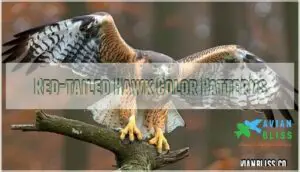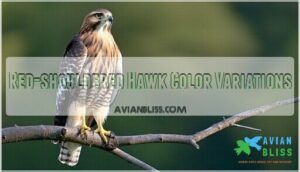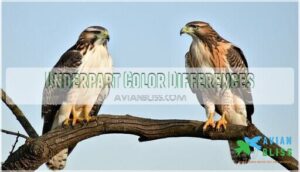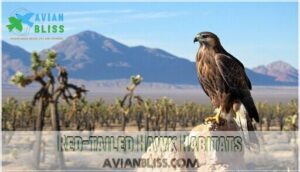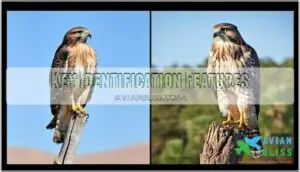This site is supported by our readers. We may earn a commission, at no cost to you, if you purchase through links.
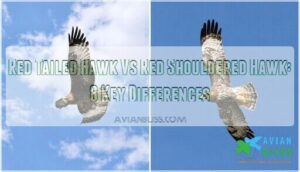
Red-shouldered hawks are more compact, with distinctive squared-off wings that arch forward slightly. The tail patterns seal the deal—red-tails flash that famous rusty-red tail (hence the name), while red-shouldered hawks sport bold black and white bars across their tails.
You’ll also notice red-shouldered hawks have that characteristic reddish shoulder patch that gives them their identity. Their calls differ too, with red-tails delivering harsh "keeeeeer" screams versus the red-shouldered’s repetitive "kee-ah" notes.
Understanding these visual cues and behavioral quirks transforms confusing hawk encounters into confident identifications.
Table Of Contents
- Key Takeaways
- Hawk Size Comparison
- Plumage and Color
- Vocalization Patterns
- Habitat and Behavior
- Key Identification Features
- Frequently Asked Questions (FAQs)
- Is it rare to see a red-shouldered hawk?
- Is it illegal to shoot a red-shouldered hawk?
- How can you tell a red-tailed hawk?
- How rare is it to see a red-shouldered hawk?
- Do Red-shouldered Hawks catch squirrels?
- How do you identify a red-tailed hawk?
- What is the difference between a red tailed hawk and a hawk link?
- Is a red tailed hawk a good bird?
- How do these hawks interact with other raptor species?
- What are their main predators or threats?
- Conclusion
Key Takeaways
- You’ll distinguish these hawks by size alone – red-tailed hawks are nearly twice as heavy (up to 3.2 pounds) with broader wings, while red-shouldered hawks max out at 1.7 pounds with more compact builds
- Their tail patterns provide instant identification – red-tailed hawks flash that famous rusty-red tail from above, while red-shouldered hawks display bold black and white bars across their tails
- You can identify them by sound before you see them – red-tailed hawks deliver harsh "keeeeeer" screams lasting 2-3 seconds, while red-shouldered hawks make repetitive "kee-ah" calls
- Their habitats reveal their hunting styles – you’ll spot red-tailed hawks soaring over open fields and farmland, while red-shouldered hawks prefer dense woodlands near water sources
Hawk Size Comparison
When you’re trying to tell red-tailed and red-shouldered hawks apart, size becomes your first reliable clue in the field.
Red-tailed hawks are noticeably larger and bulkier, with females weighing up to 3.2 pounds compared to red-shouldered hawks that max out around 1.7 pounds.
Red-tailed hawks pack nearly twice the weight of their red-shouldered cousins, making size your best field identification clue.
Red-tailed Hawk Measurements
The red tailed hawk stands as North America’s largest buteo, showcasing impressive measurements that distinguish it from other hawk species.
Males typically weigh 1.5-2.9 pounds, while females reach 1.8-3.8 pounds.
Their wingspan stretches 43-56 inches, making them formidable soaring predators.
The red tailed hawk’s physical characteristics, including its hawk eye features, play a vital role in its hunting success.
| Measurement | Males | Females |
|---|---|---|
| Body Mass | 1.5-2.9 lbs | 1.8-3.8 lbs |
| Wing Length | Under 45 inches | 48-54 inches |
| Tail Size | 7.4-10.2 inches | 7.4-10.2 inches |
Red-shouldered Hawk Measurements
When you’re studying hawk species comparison, you’ll discover that red shouldered hawks are markedly smaller than their red-tailed cousins.
Their woodland hunters typically measure 15-24 inches in length with a wingspan reaching 37-43 inches. Their compact build reflects their red shouldered hawk habitat preferences for dense forests where maneuverability matters more than raw power.
| Measurement | Range |
|---|---|
| Body Length | 15-24 inches |
| Wing Length | 37-43 inches |
| Body Mass | 1.1-1.9 pounds |
Their tail size averages 7.4-9.4 inches, providing excellent steering through canopy gaps. Females typically outweigh males by 10-12%, supporting their role as nest defenders.
The beak shape remains compact yet efficient for their red shouldered hawk diet of small mammals and amphibians. These proportions create distinctive feather patterns that aid identification during bird size comparisons.
Size Differences Between Species
Size differences between these hawk species become apparent when you compare their measurements side by side.
Red-tailed hawks clearly outweigh their red-shouldered cousins, with females showing the most dramatic size variation.
This sex dimorphism affects hunting strategies and territorial behavior patterns.
| Measurement | Red-tailed Hawk | Red-shouldered Hawk |
|---|---|---|
| Body Mass | 1.5-3.2 lbs | 1.1-1.7 lbs |
| Wing Span | 45-52 inches | 37-44 inches |
| Tail Length | Short, wide | Medium, banded |
| Overall Length | 18-26 inches | 16-24 inches |
Plumage and Color
You’ll notice striking color differences between these two hawk species that make field identification much easier once you know what to look for.
The most obvious distinction lies in their tail patterns and shoulder coloring, which give each species its distinctive name.
Red-tailed Hawk Color Patterns
Throughout the Red-tailed Hawk‘s impressive range, you’ll notice distinctive color patterns that set this hawk species apart.
Their plumage showcases remarkable variation, making bird identification techniques essential for accurate recognition:
- Tail Feathers: Rich rusty-red coloration visible from above and below
- Wing Tips: Prominent black markings contrasting against lighter underwings
- Head Plumage: Brown streaking with cream-colored throat patches
These Feather Texture variations help distinguish them from Redshouldered Hawks, while their Beak Color remains consistently dark yellow.
Red-shouldered Hawk Color Variations
You’ll notice dramatic plumage patterns that set red-shouldered hawks apart from their red-tailed cousins.
Their hawk species differences become clear when you observe their distinctive color morphs – adults display rich reddish-brown shoulders contrasting with black-and-white checkered wing bars.
Their tail feathers show bold alternating bands of black and white, creating striking plumage variation that makes bird identification techniques more straightforward than you’d expect, with dramatic plumage patterns and distinctive color morphs.
Underpart Color Differences
Looking at underpart color differences provides your clearest identification clues when distinguishing these hawk species.
Red tailed hawk displays a mostly white belly with a distinctive dark band across the breast feathers, while red shouldered hawk shows consistent rusty-orange coloring throughout its underparts.
The tail underside reveals rust-colored feathers in red tailed hawks versus brown and white banding in red shouldered hawks.
Wing linings appear pale in red tailed hawks but show rufous coloring in red shouldered species, which is a key factor in distinguishing between these two hawk species.
Vocalization Patterns
You’ll hear these hawks before you see them, and their calls provide reliable identification clues that work even when visual details are unclear.
Trust your ears when visual identification fails – these hawks announce themselves with signature calls that cut through forest noise.
Each species has distinct vocal patterns that reflect their different behaviors and temperaments in the wild, which can be considered as reliable identification clues.
Red-tailed Hawk Calls
You’ll recognize a Red-tailed Hawk by its distinctive harsh scream – a descending "keeeeer" that lasts 2-3 seconds.
This iconic bird vocalization appears frequently in movies as sound effects for eagles, though it’s actually the Red-tailed Hawk’s territorial call.
Red-tailed Hawk call patterns include:
- Territorial screams – Long, raspy cries during flight
- Courtship calls – Higher-pitched versions from males
- Alarm calls – Shorter, more abrupt hawk sounds
- Juvenile begging – Thinner, repetitive bird calls
Red-shouldered Hawk Vocalizations
Red-shouldered hawks break into their signature "kee-aah" calls during territorial disputes and courtship rituals.
Their bird vocalizations peak during breeding season, with auditory cues serving as mate communication tools.
| Feature | Description |
|---|---|
| Call Pattern | Repeated "kee-aah" sequence |
| Frequency Range | 2-3 kHz dominant pitch |
| Seasonal Peak | February-May breeding months |
| Daily Activity | Morning/afternoon hours |
Differences in Hawk Screams
When you hear hawk screams echoing through the forest, frequency analysis reveals distinct vocal patterns that separate these species.
Red tailed hawk produces a single, hoarse "keeeeer" lasting 2-3 seconds, while red shouldered hawk delivers a two-note "kee-yaah" with descending pitch.
These call types create unique sound waves – red shouldered hawk vocalizations are higher, clearer, and more repetitive than their red-tailed cousins’ piercing scream.
Understanding the hawk screech vocalization patterns is essential for identifying and studying these bird species with distinct vocal patterns.
Habitat and Behavior
Where you spot these hawks reveals their distinct lifestyles – red-tailed hawks patrol open countryside from telephone poles, while red-shouldered hawks prefer dense woodlands near water.
Their hunting tactics differ just as dramatically, with red-tails soaring high above fields and red-shoulders ambushing prey from forest perches.
Red-tailed Hawk Habitats
You’ll find Redtailed Hawks thriving across diverse bird habitats and ecosystems throughout North America.
These adaptable raptors flourish in Desert Habitats, Forest Ecosystems, Mountain Terrain, and Urban Landscapes. Their hawk habitat preferences include open country with scattered perches – think farmland, roadside corridors, and suburban parks.
Red-tailed Hawk habitat spans from sea level to 10,000 feet, making raptor conservation efforts essential across varied Wetland Areas and grasslands where they hunt effectively.
Understanding bird habitat needs is essential for installing bird habitat cameras to monitor their behavior, which is crucial for effective conservation and management of these ecosystems.
Red-shouldered Hawk Preferences
Unlike their red-tailed counterparts, red shouldered hawks prefer mature deciduous and mixed woodlands near water sources.
You’ll find them in bottomland hardwood forests, swampy areas, and riparian corridors throughout eastern North America.
These raptors show remarkable tolerance for suburban development, frequently nesting in wooded parks and residential areas with adequate tree cover and minimal disturbance during breeding seasons.
Their ability to thrive in various habitats is influenced by their adaptation strategies, which is a key factor in their success in different environments, including wooded parks and residential areas.
Hunting Behavior Comparison
These hunting masters employ vastly different strategies when pursuing prey.
Red-tailed hawks rely on patient perch-hunting and soaring surveillance, while red-shouldered hawks excel at ambush tactics from mid-canopy positions.
Understanding effective hawk hunting requires knowledge of proper Hawk Hunting Gear.
Key Hunting Behavior Differences:
- Flight Patterns – Red-tailed hawks soar high using thermals; red-shouldered hawks make short, quick flights through dense woods
- Prey Capture – Red-tails dive from heights onto ground prey; red-shoulders strike from concealed perches near water
- Hunting Success – Red-tails achieve 10-20% success rates; red-shoulders average 5-12% but hunt more frequently
- Ambush Tactics – Red-shoulders use surprise attacks in cluttered forests; red-tails prefer open-ground visual tracking
Key Identification Features
When you’re watching hawks in the field, three key features will help you quickly tell these species apart.
Focus on body shape, wing patterns, and their distinctive calls to make confident identifications every time.
Size and Body Shape
When you’re sizing up these raptors, think of it like comparing a linebacker to a gymnast.
Red-tailed hawks pack more muscle into their stockier frames, while red-shouldered hawks sport a sleeker, more athletic build that’s perfectly suited for woodland acrobatics.
Understanding key bird identification features is essential for distinguishing between these two species.
| Feature | Red-tailed Hawk | Red-shouldered Hawk |
|---|---|---|
| Body Proportions | Chunky, barrel-shaped | Lean, streamlined |
| Wing Span | 45-52 inches | 37-44 inches |
| Tail Length | Short, wide | Long, narrow |
Wing and Tail Patterns
You’ll spot these hawks by their distinctive wing shapes and tail length differences.
Red-tailed hawks display broad, rounded wings with a short, wide tail that’s rust-colored above. Red-shouldered hawks show narrower wings with a longer, banded tail featuring bold black-and-white stripes.
In flight, red-shouldered hawks reveal translucent crescents near their wing tips, while red-tailed hawks maintain steadier flight patterns with seamless wing-to-tail movements.
Understanding hawk wing shape variations is vital for accurate identification of these bird species.
Distinguishing Vocalizations
You can tell these hawks apart by their distinct vocal patterns.
Red-tailed hawk calls sound like a single, hoarse "keeeeer" scream lasting 2-3 seconds – that’s the classic raptor sound you hear in movies.
Red-shouldered hawk vocalizations are completely different: a clear, two-note "kee-yaah" call repeated several times.
The red-shouldered’s higher-pitched screaming habits make them much more vocal than their red-tailed cousins, which is a key difference in their vocal behaviors.
Frequently Asked Questions (FAQs)
Is it rare to see a red-shouldered hawk?
Red-shouldered hawks aren’t rare – they’re one of our most distinctively marked common hawks, and their numbers today are increasing.
You’ll find them in wooded areas near water throughout eastern North America and California.
They inhabit various forest habitats that support their breeding and hunting needs.
Is it illegal to shoot a red-shouldered hawk?
While government reaches for protection, nature provides vulnerability.
Under federal and state law, it’s illegal for anyone to injure, harass, kill or possess a bird of prey.
You’ll face serious consequences breaking the Migratory Bird Treaty Act.
How can you tell a red-tailed hawk?
Look for the chunky build and broad, rounded wings that distinguish this raptor from its cousins. You’ll hear that iconic harsh "keeeeer" scream echoing across open fields.
How rare is it to see a red-shouldered hawk?
Finding one’s like hitting the birding jackpot! You’ll spot them more readily in Eastern forests where they’re common.
They’re uncommon to fairly common across their range.
They’re declining in many areas, with populations decreasing due to clearing of lowland forest habitats.
Do Red-shouldered Hawks catch squirrels?
You’ll sometimes spot these hawks swooping through the trees, nabbing squirrels right off branches.
They’re quick and surprisingly strategic, using sharp talons and stealthy flight to catch tree squirrels, a favorite meal they rarely turn down.
How do you identify a red-tailed hawk?
Like a rust-colored flag flying high above the treetops, you’ll spot a red-tailed hawk by its distinctive cinnamon-red tail, broad wings, and stocky build measuring 18-26 inches long.
What is the difference between a red tailed hawk and a hawk link?
I’m unclear about what you mean by "hawk link."
Red-tailed hawks are large raptors with distinctive rust-colored tails and hoarse calls, while "hawk link" isn’t a recognized bird species or term.
Is a red tailed hawk a good bird?
When you observe a Red-tailed Hawk perched majestically on a roadside post, you’re witnessing nature’s perfect aerial predator.
These magnificent raptors excel as skilled hunters, controlling rodent populations while showcasing incredible soaring abilities that’ll leave you breathless.
How do these hawks interact with other raptor species?
You’ll find red-tailed and red-shouldered hawks competing for territory and prey, with red-tailed hawks typically dominating due to their larger size and aggressive nature.
While red-shouldered hawks often retreat to avoid confrontation.
What are their main predators or threats?
Nature’s aerial hunters aren’t invincible—they face threats from above and below.
You’ll find Great Horned Owls pose the biggest danger, attacking roosting hawks at night.
While habitat loss remains their greatest long-term threat.
Conclusion
Ready to confidently distinguish between these two hawk species?
Understanding the red tailed hawk vs red shouldered hawk differences transforms confusing encounters into precise identifications.
You’ll recognize red-tails by their larger size, broader wings, and distinctive rusty-red tail feathers.
Red-shouldered hawks display smaller frames, squared-off wings, and bold black-and-white tail bars.
Their vocalizations differ dramatically—red-tails produce harsh "keeeeeer" screams while red-shouldered hawks deliver repetitive "kee-ah" calls.
These field identification markers guarantee accurate species recognition.
- https://en.wikipedia.org/wiki/Red-tailed_hawk
- https://tpwd.texas.gov/huntwild/wild/species/redshoulderedhawk/
- https://www.audubon.org/field-guide/bird/red-tailed-hawk
- https://www.chattnaturecenter.org/visit/experience/wildlife/animal-facts/red-shouldered-hawk/
- https://www.oaklandzoo.org/animals/red-tailed-hawk

